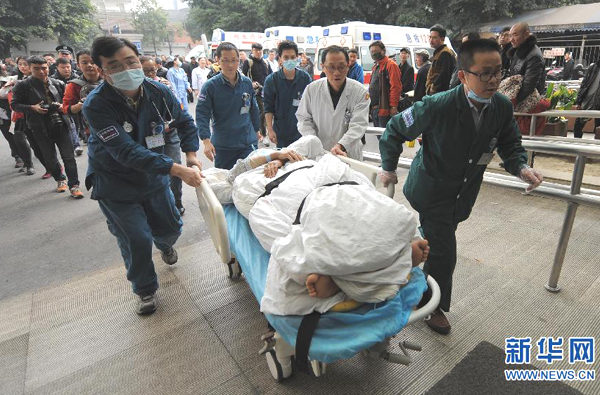More injuries reported from SW China earthquake
(Xinhua) Updated: 2014-11-25 16:25
 |
|
A man who was severely wounded in Saturday's magnitude 6.3 earthquake in Kangding county, Garze Tibetan autonomous prefecture in Southwest China's Sichuan province is transferred to West China Hospital in Chengdu for treatment, Nov 25, 2014. [Photo/Xinhua] |
KANGDING, Sichuan Province -- Injuries from Saturday's 6.3-magnitude earthquake in Southwest China's Sichuan province has climbed to 65 as of Tuesday at noon, said local government.
Previous reports said five were killed and 54 were injured. However, the number has increased as information from remote rural areas reached Kangding, capital of the Garze Tibetan Autonomous Prefecture, according to the prefecture government's publicity office.
All the injured have been sent to hospital and are in a stable condition.
The latest investigation showed the quake affected more than 108,000 people in 55 towns in Garze, damaging the homes of more than 27,400 families.
More than 9,100 displaced people had to stay in the shelters offered by the government or at their relatives'.
The central government has allocated a relief fund of 50 million yuan (8.14 million U.S. dollars) to the heavily-Tibetan populated county.
Rescuers have set up more than 1,800 tents as "temporary homes" for the quake victims. Quilts and blankets have been distributed as well.
"Currently, the life of people is fairly guaranteed as the relief supplies have been smoothly sent to them," an official with the publicity office told Xinhua.
"It's obvious that people living in the rural pastoral areas suffered worse losses, and the priority of our work now is to help them get through the winter with proper accommodation," said the official who declined to give his name.
At a resettlement in Qiangba village of the Tagong Town, the quake epicenter which is some 90 km from the county seat of Kangding, Xinhua reporters saw local Tibetans set up tents in their court yards to stay overnight.
Qiakar, a middle-aged farmer, showed the reporters the cracks on his two-story house.
"The officials told us not to stay at home at night in case of strong aftershocks. It's not safe inside," said Qiakar.
Now the family of four is sleeping in a tent covering roughly seven square meters, with quilts piled in one corner.
"I didn't feel cold sleeping here at night. The quilts are thick enough and wind can't get in," said Qiakar's younger boy.
Telecom services, power supply and traffic to the quake zone have all resumed. But water supply is still off in Tagong and rescuers are working around the clock to repair the facilities.
This strong earthquake is the latest to hit Sichuan, which neighbors Tibet Autonomous Region. A massive 8.0 magnitude earthquake struck Wenchuan on May 12, 2008, resulting in more than 80,000 people reported dead or missing. On April 20, 2013, a 7.0-magnitude quake hit Lushan, killing at least 196.
Kangding lies on a geologically active belt and has reported nine earthquakes of 7 magnitude or above over the last 400 years.
- Govt encourages people to work 4.5 days a week
- Action to be taken as HIV cases among students rise
- Debate grows over reproductive rights
- Country's first bishop ordained in 3 years
- China builds Tibetan Buddhism academy in Chengdu
- Authorities require reporting of HIV infections at schools
- Typhoon Soudelor kills 14 in East China
- Police crack down on overseas gambling site
- Debate over death penalty for child traffickers goes on
- Beijing to tighten mail security for war anniversary







